Data dive: What wins in close games?
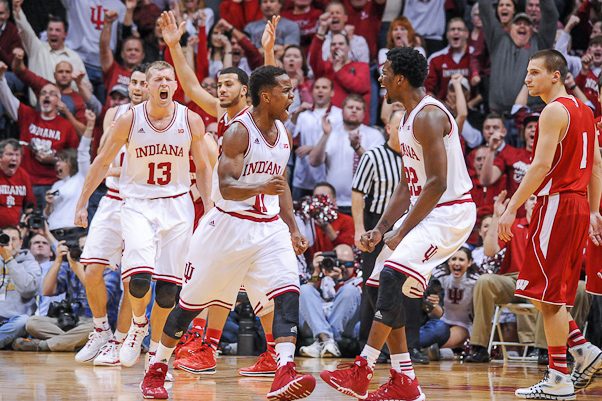
One of the harsh realities of Indiana’s season thus far is that, in so many games, they’ve been really close. How close? Six of their eight Big Ten losses have been by seven or less points and the average margin of defeat in these games is just 4.5 points.
Only three of Indiana’s 13 Big Ten games have not been “close”. (For the duration of this article a “close” game indicates that the score difference was five points or less at some point in the final five minutes of the game.) Only Ohio State and Minnesota have played in more close games than Indiana this season and each has a better winning percentage than the Hoosiers. Though no program deals in “could-haves,” the reality is that the season might have a much different feel if IU had closed out some of these tight games, particularly in conference play.
Here’s a look at how each Big Ten team has fared in close games for both the conference season and the non-conference season:
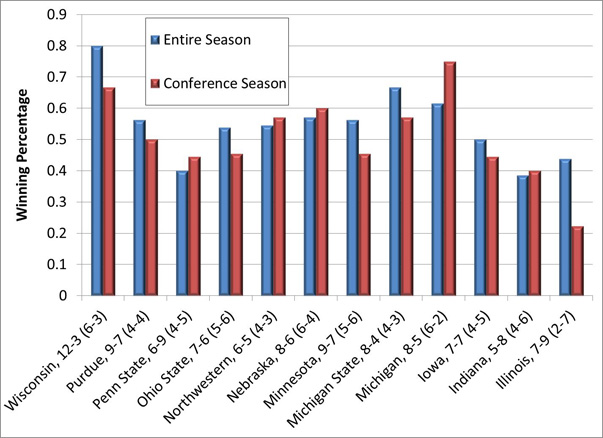
It is no surprise that the teams at the top of the conference standings — Michigan, Michigan State, and Wisconsin — are some of the best in the league at winning close games. Likewise, teams like Indiana, Illinois, and Penn State have had trouble converting these close games into wins and find themselves looking up in the standings.
So what exactly are the good teams doing that the others are not?
By analyzing the statistics for each team during “crunch time” (less than five minutes remaining and score differential within five points) it is possible to pick out the key statistics that correlate to a higher winning percentage in the close games.
On offense, the two metrics that stood out were effective field goal percentage and second-chance points. Turnover rate also showed a correlation, but was not as strong, while stats like assist rate and points off of turnovers seem to have little or no effect on the outcome.
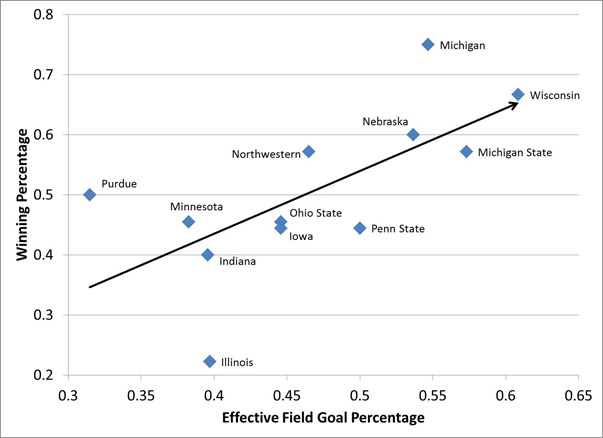
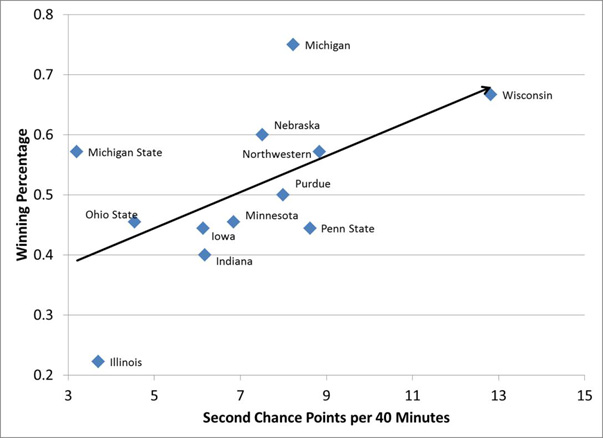
On the defensive end, two metrics show very strong correlations with win percentage, while most others show little or no correlation. The two most important defensive statistics in close games are points off of turnovers allowed and second-chance points allowed.
While it might be unexpected that stats like effective field goal percentage allowed and defensive turnover rate do not appear to be important, it is not surprising that second-chance points and points off of turnovers are important as both of these stats equate to extra opportunities for the offense.
The fact that these are the only two defensive metrics that stand out really stresses the fact that affording an opponent these extra opportunities quickly destroys a team’s chances of winning a close game.
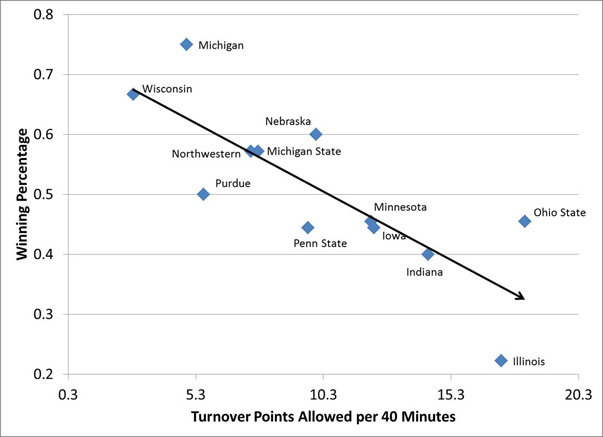
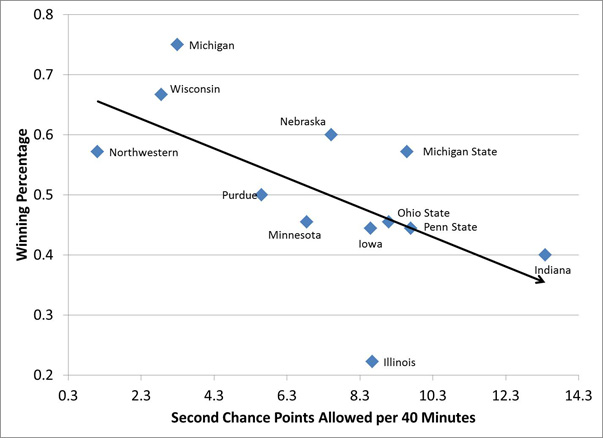
In a close game anything can make the difference between a win and a loss, but from a high level perspective there seem to be a few things that are more important than others.
Based on statistical evidence from the Big Ten season thus far, the recipe for success seems relatively simple: on offense, shoot the ball well and score on your own misses. And on defense, don’t let the opposing team score on extra opportunities. Big Ten teams that haven’t done these things tend to lose more close games than they win, while the ones that can execute this strategy have been successful.
Of course, the more pertinent question here is what makes the difference in close games for Indiana?
Pulling data from crunch time in each of Indiana’s close games gives insight to what exactly makes the difference between a win and a loss for IU — specifically, what statistical measures have the biggest disparity in Indiana’s wins versus its losses. On offense, three metrics stand out: effective field goal percentage, turnover rate and assist rate.
This basically says that the Hoosiers lose when they struggle to score and when they turn the ball over too much, something even the casual Indiana knows from watching the games.
However, the assist rate is a powerful factor because it indicates that Indiana doesn’t just need to shoot a better percentage to win, but that they need to run an offense where players create for each other. In the recent game at Northwestern, the Wildcats got the score within five points twice in the final five minutes and each time the Hoosiers responded on the ensuing possession with an assist and a made basket.
It is worth mentioning that in Indiana’s five close wins this season (LIU-Brooklyn, at Penn State, Wisconsin, Michigan, at Northwestern) the Hoosiers have not once turned the ball over in crunch time. That comes out to 32 possessions and 18 minutes in crunch time without a single turnover.
Defensively, only points off of turnovers allowed stands out as a correlating factor between wins and losses. Though points off of turnovers is a statistic for the opposing team, it is really just an extension of Indiana’s offensive turnover rate.
What the lack of defensive significance indicates is that IU’s defense during crunch time has been consistent and that the factors that truly decide the outcome of these close games is Indiana’s offensive performance. The figure below shows the statistical differences between the previously discussed factors for the Hoosiers’ close wins and losses this season.
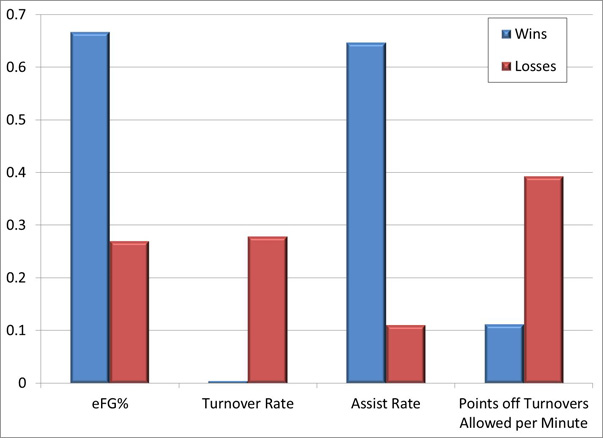
The assist and turnover rates are particularly different between wins and losses, with Indiana boasting a turnover rate of zero and an assist rate of 65 percent in its wins. The need for the team to improve on turnovers is obvious, but the assist rate brings to light the importance of shot quality on offense. The increased effective field goal percentage in wins is likely a byproduct of the high assist rate.
Indiana has a gruesome five-game stretch to close out the season, consisting of five of the top six teams in the conference standings. Up to this point, 11 of the team’s 13 conference games have come down to crunch time and if that remains the case Indiana will have a chance to knock off some quality teams.
The Hoosiers took a step in the right direction against Northwestern, keeping turnovers low and getting quality looks off of good ball movement on offense, but they’ll have to step up their game against the Big Ten’s best teams. With a consistent defense, look for the quality of Indiana’s offense during crunch time to be the deciding factor in the team’s ability to boost their postseason resume before the Big Ten tournament.
Filed to: Statistics
